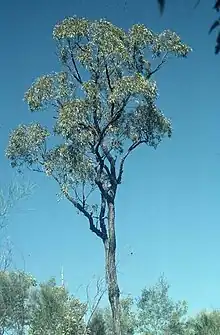Eucalyptus suffulgens
Eucalyptus suffulgens is a small to medium-sized tree that is endemic to Queensland. It has hard ironbark on the trunk and larger branches, smooth bark above, lance-shaped adult leaves, flower buds in groups of seven on the ends of branchlets, white flowers and barrel-shaped fruit.
| Eucalyptus suffulgens | |
|---|---|
 | |
| Scientific classification | |
| Kingdom: | Plantae |
| Clade: | Tracheophytes |
| Clade: | Angiosperms |
| Clade: | Eudicots |
| Clade: | Rosids |
| Order: | Myrtales |
| Family: | Myrtaceae |
| Genus: | Eucalyptus |
| Species: | E. suffulgens |
| Binomial name | |
| Eucalyptus suffulgens | |
Description
Eucalyptus suffulgens is a tree that typically grows to a height of 25 m (82 ft) and forms a lignotuber. It has dark grey to black ironbark on the trunk and larger branches, the thinner branches often with smooth bark. Young plants and coppice regrowth have glossy green, lance-shaped leaves that are 70–130 mm (2.8–5.1 in) long and 6–25 mm (0.24–0.98 in) wide. Adult leaves are the same shade of glossy green on both sides, lance-shaped, 80–160 mm (3.1–6.3 in) long and 15–25 mm (0.59–0.98 in) wide tapering to a petiole 8–20 mm (0.31–0.79 in) long. The flower buds are arranged on the ends of branchlets in groups of seven on a branched peduncle 10–20 mm (0.39–0.79 in) long, the individual buds on pedicels 3–10 mm (0.12–0.39 in) long. Mature buds are oval to pear-shaped, 7–10 mm (0.28–0.39 in) long and 4–5 mm (0.16–0.20 in) wide with a conical operculum that is shorter and narrower than the floral cup. Flowering occurs from April to September and the flowers are white. The fruit is a woody, barrel-shaped capsule 7–13 mm (0.28–0.51 in) long and 5–10 mm (0.20–0.39 in) wide with the valves below rim level.[2][3]
Taxonomy and naming
Eucalyptus suffulgens was first formally described in 1991 by Ken Hill and Lawrie Johnson in the journal Telopea from specimens collected by Johnson near Biloela in 1971.[3][4] The specific epithet (suffulgens) is from the Latin sub- meaning "somewhat" and fulgens meaning "shining", referring to the leaves of the species.[3]
Distribution and habitat
This ironbark is locally abundant on shallow soil over sandstone on ranges and escarpments in the central ranges of Queensland, including the Blackdown Tableland.[2][3]
Conservation stutus
This eucalypt is classified as "least concern" under the Queensland Government Nature Conservation Act 1992.[5]
See also
References
- "Eucalyptus suffulgens". Australian Plant Census. Retrieved 3 January 2020.
- "Eucalyptus suffulgens". Euclid: Centre for Australian National Biodiversity Research. Retrieved 28 May 2020.
- Hill, Kenneth D.; Johnson, Lawrence A.S. (1 March 1991). "Systematic studies in the eucalypts - 4. New taxa in Eucalyptus (Myrtaceae)". Telopea. 4 (2): 341–343. doi:10.7751/telopea19914932.
- "Eucalyptus suffulgens". APNI. Retrieved 3 January 2020.
- "Eucalyptus suffulgens". WetlandInfo. Queensland Government. Retrieved 14 November 2016.